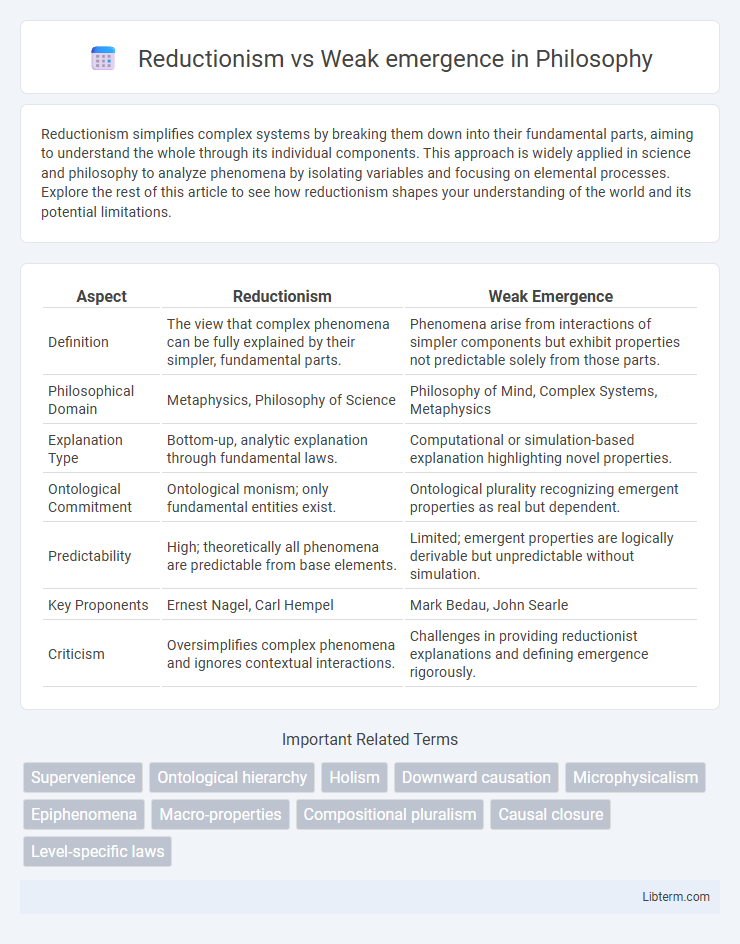Reductionism simplifies complex systems by breaking them down into their fundamental parts, aiming to understand the whole through its individual components. This approach is widely applied in science and philosophy to analyze phenomena by isolating variables and focusing on elemental processes. Explore the rest of this article to see how reductionism shapes your understanding of the world and its potential limitations.
Table of Comparison
| Aspect | Reductionism | Weak Emergence |
|---|---|---|
| Definition | The view that complex phenomena can be fully explained by their simpler, fundamental parts. | Phenomena arise from interactions of simpler components but exhibit properties not predictable solely from those parts. |
| Philosophical Domain | Metaphysics, Philosophy of Science | Philosophy of Mind, Complex Systems, Metaphysics |
| Explanation Type | Bottom-up, analytic explanation through fundamental laws. | Computational or simulation-based explanation highlighting novel properties. |
| Ontological Commitment | Ontological monism; only fundamental entities exist. | Ontological plurality recognizing emergent properties as real but dependent. |
| Predictability | High; theoretically all phenomena are predictable from base elements. | Limited; emergent properties are logically derivable but unpredictable without simulation. |
| Key Proponents | Ernest Nagel, Carl Hempel | Mark Bedau, John Searle |
| Criticism | Oversimplifies complex phenomena and ignores contextual interactions. | Challenges in providing reductionist explanations and defining emergence rigorously. |
Introduction to Reductionism and Weak Emergence
Reductionism explains complex systems by breaking them down into their fundamental components, emphasizing that all phenomena can be fully understood through the properties and interactions of these basic parts. Weak emergence describes system properties that arise from simple interactions at lower levels but require computational simulation or analysis to be fully understood, highlighting patterns that are not immediately deducible from the components alone. This distinction underscores the difference between explaining phenomena through constituent parts versus recognizing emergent behaviors that are predictable yet not straightforwardly derivable from those parts.
Defining Reductionism: Core Concepts
Reductionism centers on explaining complex systems by breaking them down into their most basic components, highlighting that the properties of the whole system are fully determined by those of its parts. It asserts that higher-level phenomena can be understood entirely through lower-level physical or chemical interactions without needing to invoke additional principles. This approach contrasts with weak emergence, where system-level patterns arise from interactions but remain logically deducible from the underlying components.
Defining Weak Emergence: Key Principles
Weak emergence is characterized by system-level properties arising from simple interactions among components, which are predictable only through simulation or detailed analysis rather than reduction to basic laws. These emergent properties cannot be fully explained by examining individual parts alone, emphasizing the importance of macroscopic patterns in understanding complex systems. Weak emergence challenges reductionism by highlighting that novel behaviors emerge at higher organizational levels despite being grounded in lower-level processes.
Historical Perspectives and Philosophical Roots
Reductionism traces back to ancient Greek atomism and gained prominence through Descartes' mechanistic philosophy, emphasizing that complex phenomena can be fully explained by their simplest parts. Weak emergence, rooted in 20th-century philosophy of mind and systems theory, challenges strict reductionism by arguing that higher-level properties arise from lower-level interactions without being predictable or deducible solely from those parts. Philosophical debates between figures like Nagel, Kim, and Bedau highlight tensions regarding the explanatory power and ontological status of emergent properties versus reductive explanations.
Comparing Reductionism and Weak Emergence
Reductionism explains complex systems by breaking them down into their simplest parts and understanding these components individually, emphasizing causality and predictability from foundational laws. Weak emergence recognizes that some system-level behaviors arise from interactions of components but remain explainable through simulation or analysis of these interactions without invoking new fundamental laws. Comparing both, reductionism seeks complete explanation via base elements, while weak emergence accepts system patterns as novel but derivable, highlighting limits of predictability and the importance of computational methods in understanding complexity.
Examples of Reductionism in Science
Reductionism in science is exemplified by the atomic theory of matter, where complex substances are explained through interactions of atoms and molecules. Another example is genetics, where biological traits are understood via DNA sequences and gene functions. Neuroscience also applies reductionism by linking mental processes to neuronal activity and brain structures.
Illustrative Cases of Weak Emergence
Illustrative cases of weak emergence often include cellular automata like Conway's Game of Life, where complex patterns arise from simple rules without explicit design. Another example is the flocking behavior of birds, which emerges from local interactions between individuals without centralized control. These cases highlight how macroscopic properties emerge from microscopic rules, aligning with weak emergence rather than strict reductionism.
Limitations of Reductionism in Complex Systems
Reductionism struggles to fully explain complex systems due to its focus on breaking phenomena into isolated components, which overlooks emergent properties arising from intricate interactions. Weak emergence highlights that certain system-level behaviors cannot be predicted solely by analyzing individual parts, emphasizing the limitations of reductionist approaches in accounting for holistic patterns. Complex systems such as neural networks and ecosystems demonstrate that macro-level phenomena often require models integrating both micro-level details and emergent dynamics.
Advantages and Challenges of Weak Emergence
Weak emergence offers the advantage of explaining complex system behaviors through interactions at the micro-level without requiring reduction to fundamental components, enabling better modeling of phenomena like consciousness and social dynamics. Challenges include the difficulty of predicting emergent properties solely from underlying parts due to computational irreducibility and the lack of universally accepted formal definitions. This approach bridges the gap between reductionism and holism by acknowledging novel macro-properties while preserving the significance of micro-level interactions.
Future Directions in the Debate
Future directions in the debate between reductionism and weak emergence emphasize integrating computational modeling to bridge micro-level interactions with macro-level phenomena. Advances in complex systems theory and network science offer promising frameworks to quantify emergent properties without abandoning underlying physical laws. Continued interdisciplinary research aims to refine criteria for predicting emergent behaviors, enhancing the explanatory power of weak emergence alongside reductionist approaches.
Reductionism Infographic

 libterm.com
libterm.com